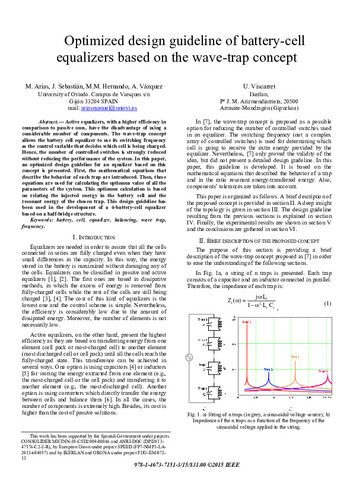Optimized design guideline of battery-cell equalizers based on the wave-trap concept
Palabra(s) clave:
Battery
Balancing
Wave trap
Frequency
Fecha de publicación:
Editorial:
IEEE
Versión del editor:
Descripción física:
Resumen:
Active equalizers, with a higher efficiency in comparison to passive ones, have the disadvantage of using a considerable number of components. The wave-trap concept allows the battery cell equalizer to use its switching frequency as the control variable that decides which cell is being charged. Hence, the number of controlled switches is strongly reduced without reducing the performance of the system. In this paper, an optimized design guideline for an equalizer based on this concept is presented. First, the mathematical equations that describe the behavior of each trap are introduced. Then, these equations are used for calculating the optimum value of all the parameters of the system. This optimum calculation is based on relating the injected energy in the battery cell and the resonant energy of the chosen trap. This design guideline has been used in the development of a 4-battery-cell equalizer based on a half-bridge structure
Active equalizers, with a higher efficiency in comparison to passive ones, have the disadvantage of using a considerable number of components. The wave-trap concept allows the battery cell equalizer to use its switching frequency as the control variable that decides which cell is being charged. Hence, the number of controlled switches is strongly reduced without reducing the performance of the system. In this paper, an optimized design guideline for an equalizer based on this concept is presented. First, the mathematical equations that describe the behavior of each trap are introduced. Then, these equations are used for calculating the optimum value of all the parameters of the system. This optimum calculation is based on relating the injected energy in the battery cell and the resonant energy of the chosen trap. This design guideline has been used in the development of a 4-battery-cell equalizer based on a half-bridge structure
ISBN:
Patrocinado por:
Spanish Government under projects CONSOLIDER MICINN-10-CSD2009-00046 and ANRI-DOC (DPI2013- 47176-C2-2-R), by European Union under project SPEED (FP7-NMP3-LA- 2013-604057) and by IKERLAN and ORONA under project FUO-EM-072- 13
Colecciones
Ficheros en el ítem




